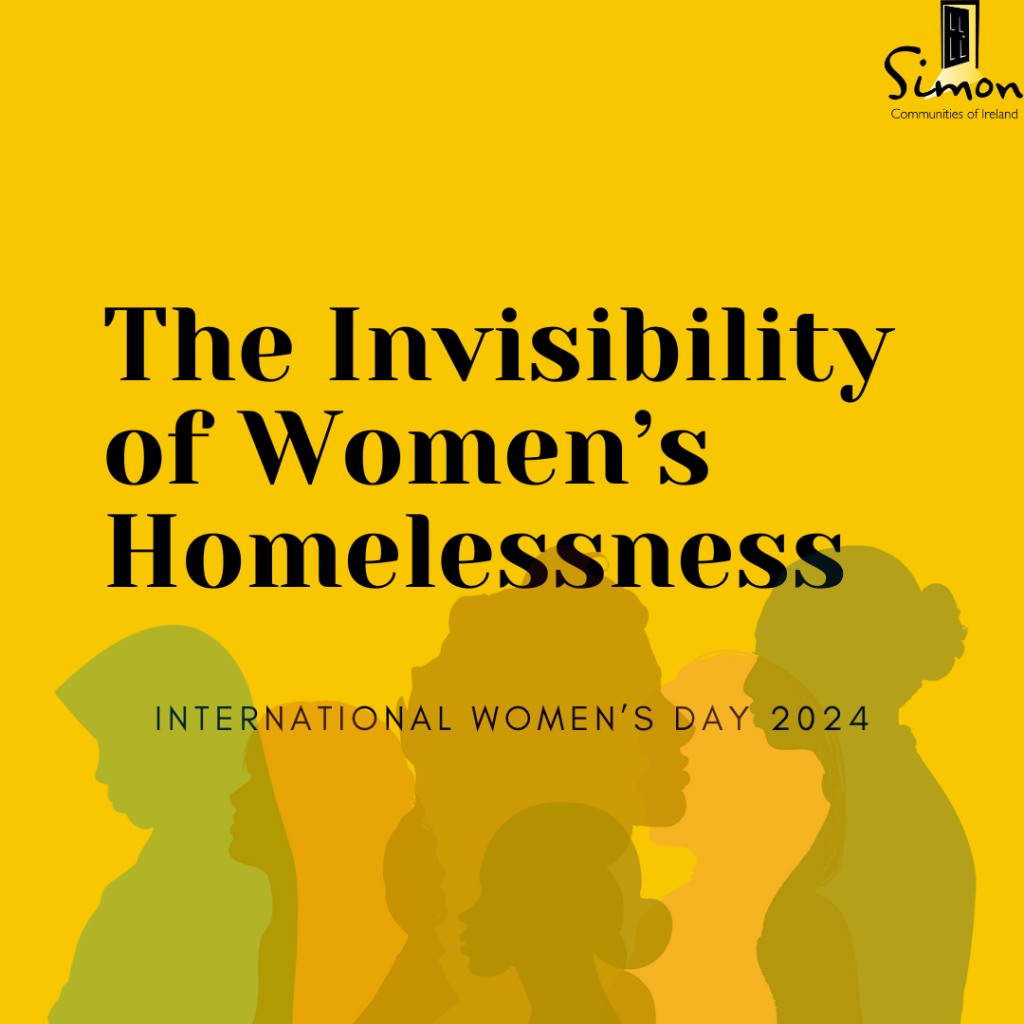
International Women’s Day is an opportunity to celebrate women, but we also must recognise the challenges that are faced by women. One of the significant challenges to ensuring the needs of women experiencing homelessness is that they can be rendered invisible by a limited understanding of homelessness.
This blog was inspired by our February #SimonTalks webinar with Dr. Paula Mayock.
In this blog, we focus on how the measurement of homelessness bolsters homeless women’s invisibility. It is important to note that there are several other intersecting factors that account for this invisibility such as policy and research, and service responses to homelessness.
Defining Homelessness
Official homelessness statistics often underrepresent the true scale of women’s experiences of homelessness. This is because common definitions of homelessness are often derived from administrative data which encompasses those living in homeless emergency accommodation and those sleeping rough. This is the case here in Ireland, where official homeless statistics published each month only include those residing in homeless specific emergency accommodation which is funded by the state.
This narrow definition of homelessness can underrepresent the true reality and scale of women’s homelessness, and indeed homelessness more generally. Because of this narrow definition, women’s homelessness has traditionally been categorised as a relatively minor social problem – a subcategory of homelessness, with the main focus on lone adult men (Mayock and Bretheron, 2021).
Domestic and Gender-Based Violence and Homelessness
Across Europe (including here in Ireland), there are disconnects between domestic violence and homelessness services, as these services are often developed and funded separately. This is despite the well-established links between domestic, gender and sexual based violence and homelessness. Research has found that domestic violence and other forms of gender-based violence can push women towards a trajectory of housing instability and homelessness. Women who exit abusive relationships often confront additional barriers to housing security. This is especially relevant given the current housing affordability and supply crisis. Examples of these barriers include, but are not limited to, housing market discrimination, a lack of affordable housing and women’s exclusion from the labour market. This means that in the absence of a clear path to housing, leaving abusive relationships can often become a pathway to homelessness. This highlights the intersectionality of relationship, personal and structural drivers of homelessness.
Despite the strong association between domestic violence and homelessness, women who are forced to flee their homes due to domestic abuse are not counted in official homelessness statistics. It is worth noting that this data was collected before in the Dublin region. In 2008, survey-based research on homelessness was conducted which utilised a broader definition of homelessness, which included those fleeing domestic violence (Homeless Agency, 2008). Unfortunately, another count such as this has not been completely since. There are countries who do include women fleeing domestic violence in their official homelessness statistics, such as Norway and Sweden (Benjaminsen et al., 2020).
Hidden Homelessness and Service Avoidance
Evidence suggests that women often only come into contact with homeless services once they have exhausted all alternative informal options and are much more likely to experience hidden forms of homelessness (Mayock and Bretheron, 2021). An Irish study on women’s journeys to homelessness, found that the majority of women had lived in accommodation provided by family or friends rather than by homeless service providers (Mayock and Sheridan, 2012). Women often avoid services as an attempt to conceal their status as ‘homeless’ due to stigma, and due to fear of male-dominated service settings (Mayock et al., 2015; Reeve et al., 2006).
Hidden forms of homelessness such as staying with family/friends are not counted in official homelessness statistics. While acknowledging that it is difficult cohort to capture, it is important that we can gain an understanding of the scale, along with the needs of this cohort in order to respond effectively and prevent this form of homelessness from occurring. This data is collected in other countries, such as the four Nordic countries (Benjaminsen et al., 2020).
Conclusion
Given women’s tendency to rely on informal ‘solutions’, the disconnect between domestic violence and homeless service provision, a large portion of women’s homelessness remains underrepresented in official homelessness statistics. This highlights how the measurement of homelessness bolsters the invisibility of women’s homelessness.
Although there has been a wider recognition of the extent of women’s homelessness and a recognition of hidden forms of homelessness, official homelessness data across Europe still tends to concentrate on the most visible categories of homelessness: rough sleeping and sheltering in homeless emergency accommodation.
In order to uncover the true scale of women’s homelessness, a broader definition of homelessness needs to be employed, such as the European Typology of Homelessness and Housing Exclusion (ETHOS), which includes those living in women’s shelters, those living in insecure accommodation and those living under the threat of violence.
References
#SimonTalks
Catch up on our #SimonTalks webinar with Dr. Paula Mayock to learn more about Women’s Experience of Homelessness:
Author: Rebecca Hamilton


